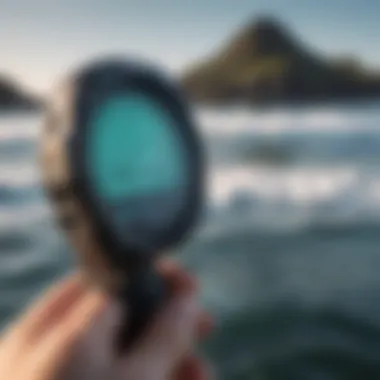The Importance of Real-Time Temperature in Watersports


Intro
In the vibrant world of watersports, the temperature of the water can greatly shape the experience for both novices and seasoned enthusiasts. Whether you’re catching waves, diving into the deep blue, or paddling across a serene lake, understanding real-time temperature isn’t just a technical detail; it’s a pivotal piece of the puzzle that affects safety, performance, and the very enjoyment of the sport.
When enthusiasts venture out, knowing the water temperature allows them to prepare adequately. Is the water warm enough for a leisurely swim, or should one bundle up in a wetsuit? These decisions can be the difference between a fun day in the water and a chilly ordeal that might deter anyone from enjoying aquatic activities altogether.
Additionally, real-time temperature data has critical implications for safety. Rapidly changing conditions can create unexpected challenges—from hypothermia risks in colder waters to overheating in warmer environments. Understanding how temperature impacts various aspects of watersports can enhance not only the athletic performance but also ensure the well-being of those involved in these thrilling activities.
In this exploration, we won’t just skim the surface. We’ll delve deep into the essential techniques and skills needed for both beginners stepping into the watersports arena and seasoned adventurers pushing their limits. We’ll take a look at the must-have gear tailored for each sport and share tips on selecting the right equipment to match one’s activities and environmental conditions. By the end of this narrative, you’ll grasp the nuances of how real-time temperature influences a wide array of water-based pursuits, enriching both your knowledge and skills in the aquatic world.
Let's navigate the waters of understanding temperature in watersports, starting with the essential techniques and skills.
The Role of Temperature in Watersports
Understanding temperature's role in watersports isn’t just an academic exercise; it’s essential for ensuring safety, enhancing performance, and fostering environmental consciousness among participants. Anyone involved in these activities—whether they are seasoned veterans or greenhorns—needs to grasp how temperature can dramatically impact every phrase of their aquatic endeavors.
In watersports like sailing, kayaking, or diving, temperature governs not just how comfortable you feel but also influences aspects like water density, buoyancy, and even wind patterns. When it comes to planning an outing on the water, knowing the temperature helps you choose the right gear, make accurate assessments about weather conditions, and lay the groundwork for a successful day on the water.
Furthermore, temperature plays a critical role in the overall performance of both the athlete and their equipment. For instance:
- The sleek design of a sailboat glides more efficiently in certain temperatures.
- A diver may find that cooler waters require different gear to ward off the risks of hypothermia.
Importance of Real-Time Data
In today's fast-paced environment, real-time temperature data has become the lifeblood of effective decision-making in watersports. This data isn’t your run-of-the-mill weather report; it captures fluctuations that can happen over very short time spans. With real-time monitoring, individual water conditions might be understood more precisely, and activities can be adjusted to fit them.
• Enhancing Safety: Knowing the current temperature allows athletes to assess risk factors, such as the likelihood of hypothermia or heat exhaustion. • Better Performance: Real-time data also allows athletes to tweak their strategy, which can lead to improved performance. Competitive sailors, for example, can adjust their sails based on quickly changing wind and water temperatures. • Informing Training: For coaches, having instant access to temperature data can modify training regimens to better befit climatic conditions.
"In the world of watersports, every degree counts. Real-time data can be the difference between an enjoyable time on the water and a safety incident."
Historical Context of Temperature Tracking
Long before the rise of digital sensors and mobile apps, adventurers had their own techniques for tracking temperature changes. Historical contexts can shed light on how critical temperature measurement has always been in watersports. In the past, rudimentary thermometers were often used, but the reliance on these tools was fraught with limitations. Their accuracy depended largely on the skill of the operator and the conditions under which they were taken.
Water athletes in ancient times relied on gut instincts and environmental cues. A shift in wind or the color of the water could signal a change in temperature. While many would claim that experience in watersports offered a certain know-how, this trial-and-error approach lacked the precision modern technology can provide.
The evolution from these basic methods to today’s real-time monitoring is significant—not just as a convenience but as a necessity. With climate conditions changing rapidly, having immediate access to accurate temperature data has become more than just a passing thought; it’s a pivotal element for safeguarding lives and ecosystems.
Thus, understanding temperature’s role in watersports melds history with modernity, painting a rich picture of how far we have come and what remains crucial today.
Technology Behind Temperature Monitoring
In today's fast-paced world of watersports, having real-time temperature data is not just a luxury—it's becoming an imperative. The growing inclination towards safety and performance is driving advancements in temperature monitoring technology. Let’s dive into the specifics of how these technologies work and why they are crucial.
Types of Temperature Sensors
To start off, understanding the various types of temperature sensors is essential. These sensors can transform your experience on the water:
- Thermocouples: These are versatile and can measure temperature differences. They work by generating a voltage when there is a temperature variation between two metals. It's like having an early warning alarm for sudden changes in temperature.
- Resistance Temperature Detectors (RTDs): Known for their precision, RTDs operate by using the change in electrical resistance of materials as temperature changes. Envision being able to keep your cool, even when the water temperature is on the rise!
- Infrared Sensors: These sensors provide measurements without direct contact, perfect for getting a read on your surroundings while you glide through the waves. Imagine not having to stop mid-surf to check the temperature!
Knowing these options allows watersport enthusiasts to choose the right sensor based on their specific needs, whether it's sailing, surfing, or diving.
Integration of IoT in Watersports
The Internet of Things (IoT) is shaking things up in more ways than one. By connecting temperature sensors to the cloud, athletes can receive real-time data via their smartphones or smartwatches.
- Data Accessibility: This connectivity offers unprecedented accessibility. Travelers can discover water conditions at their favorite spots without being physically present.
- Predictive Analysis: IoT enables users to analyze historical data and predict trends. Imagine knowing the best time to hit the waters based on past temperatures!
- Environmental Monitoring: With IoT, weather stations can relay information about changing conditions, which can be crucial for planning safe trips.
The integration of IoT goes beyond convenience; it creates a tailored experience that is both safer and more enjoyable for watersport enthusiasts.


Wearable Technology for Temperature Monitoring
Wearable technology is carving out its share of the spotlight in temperature monitoring as well. From smartwatches to specialised wristbands, these devices are becoming essential tools in the water sports arena.
- Smartwatches: Devices like the Garmin Fenix series are not just for telling time. They come equipped with sensors that measure water temperature, ensuring you're always in the know about the elements.
- Fitness Trackers: Some fitness trackers specially designed for water activities do more than count strokes. They keep tabs on your body temperature, allowing you to know when you're pushing your limits.
Being aware of your core temperature can be a lifesaver, especially in extreme conditions.
"Temperature monitoring technology is not only about improving performance but also about enhancing safety. Knowledge is power, especially in unpredictable environments like the ocean."
The technology behind temperature monitoring is setting a new paradigm in watersports. It simplifies the complexities of understanding temperature impacts and facilitates data-driven decision-making. As we continue to embrace these advancements, we not only heighten our performance but also safeguard our experiences in the ever-changing aquatic world.
Effects of Temperature on Water Conditions
Temperature in the aquatic environment is like a hidden hand guiding various processes—from the currents that drift in the oceans to the migration patterns of fish. Understanding how temperature shapes these conditions is crucial for watersports enthusiasts, as it not only ensures safety but also enhances performance.
Impact on Water Currents
Water currents are like the lifeblood of the ocean, each fluctuation influenced by temperature variations. When we speak of currents, we aren’t just talking about surface movements. Different temperatures create layers in the water column which interact uniquely. Warm water tends to stay on the surface while cooler, denser water sinks below. This often leads to a process called thermohaline circulation. Essentially, it’s a dance of different water layers, influenced heavily by temperature.
When temperatures fluctuate due to unseen factors, such as weather changes or seasonal shifts, currents can shift dramatically. This variation impacts several watersports activities. For instance, sailing enthusiasts need to be aware of how warm surface waters can lead to lighter winds, while cooler waters might result in stronger gusts. Those venturing into the surfing scene should also consider that different current patterns could dictate the best spots to catch waves. If these enthusiasts are not in tune with these changes, they may end up in unpredictable conditions, which could potentially put lives at risk.
Thermal Stratification and Its Implications
A fascinating effect of temperature on water conditions is thermal stratification. This occurs when bodies of water form distinct temperature layers, where warmer water caps cooler water beneath. The implications of such stratification are extensive. In larger bodies of water, like lakes, this can impact how oxygen is distributed, affecting aquatic ecosystems.
For example, in summer, this stratification can lead to hypoxic conditions at deeper levels, where fish and other aquatic life might struggle to survive. In terms of watersports, this knowledge is vital for activities like fishing. Anglers need to be aware of where fish are likely to be—often just below the thermocline where the water is cooler and richer in nutrients. Regardless of whether one is fishing, sailing, or engaging in diving, understanding thermal stratification will ensure a better appreciation of how temperature not only affects the experience but also the aquatic ecosystem itself.
Influence on Aquatic Life
Temperature plays a significant role in the behavior and distribution of aquatic life. Many species have specific temperature ranges they thrive in; exceeding or dropping below these can lead to stress and in some cases, mortality. Imagine a world where fish migration patterns are disrupted. Such shifts can ripple through the food chain, impacting not just fish populations but the entire marine ecosystem.
For watersports enthusiasts, being mindful of the water temperature can elevate the experience. For instance, during a diving expedition, divers can observe how different species congregate around thermal gradients. These changes can determine where schools of fish will be located, thus presenting opportunities for nature enthusiasts. Furthermore, surfers and kayakers will notice that different temperatures affect the types of marine fauna that might inhabit a particular area—certain seals or dolphins might become more prevalent in warm water, while cooler waters might attract different species altogether.
"The temperature of water is not just a number on a gauge; it dictates the life cycles, migration patterns, and health of aquatic environments."
Therefore, a keen understanding of how temperature impacts water conditions is essential for those involved in various watersport activities. By acknowledging these factors, enthusiasts can make informed decisions while contributing to the conservation of our fragile aquatic ecosystems.
Safety Considerations in Variable Temperatures
Understanding temperature fluctuations while engaging in watersports is not just an academic concern; it’s vital for ensuring safety and enhancing the experience. When temperatures dive or soar unexpectedly, it can catch even seasoned enthusiasts off guard. Real-time temperature awareness empowers athletes to make informed choices, which could play a crucial role in preventing accidents and health issues.
Hypothermia Risks
When the mercury dips, the danger of hypothermia lurks like a shadow on cold waters. This condition occurs when body temperature falls below the normal range, leading to reduced mental function and physical coordination. Enthusiasts participating in activities like kayaking or surfing should be particularly vigilant. Wearing the right gear, such as wetsuits or drysuits, can insulate the body against cold water, but understanding when conditions are not suitable is equally important.
"To ignore the warning signs of hypothermia is to play with fire—stay alert and prepared."
Signs of hypothermia can vary but typically involve shivering, confusion, and lethargy. Keep an eye on fellow participants; if someone seems off, addressing the situation quickly could be the difference between a remedy and a rescue.
Heat Stress and Hydration
On the flipside, excessive heat can cause heat stress—a condition that can sneak up on you when transcending from water activities into direct sunlight. Dehydration becomes a significant concern, particularly when engaging in physically demanding sports like sailing or wakeboarding. It's imperative to drink plenty of fluids before, during, and after activities.
Some practical tips to avoid heat stress include:
- Stay Hydrated: Incorporate electrolyte-rich drinks, especially if it's a scorcher.
- Seek Shade: When taking breaks, find refuge from the blazing sun.
- Monitor Your Body: Be attuned to symptoms like headache, dizziness, or nausea.
A simple practice of checking temperature conditions before heading out can save you from the undue strain that heat can impose.


Preparing for Temperature Fluctuations
To navigate the unpredictable nature of water-related activities, preparation is paramount. Understanding that temperatures can diverge dramatically within a single day or from morning to afternoon can offer significant advantages.
Here are some strategies for managing temperature fluctuations effectively:
- Layered Clothing: Dressing in layers allows you to adjust easily. Fleece and moisture-wicking fabrics can be very beneficial.
- Know Your Environment: Stay informed about local climate patterns and forecasts. Websites and apps give real-time data, so using them can help you plan effectively.
- Emergency Kits: Always carry a basic first-aid kit, including remedies for both hypothermia and heat-related conditions.
By grasping the varying impact of temperature on the water and its activities, watersport enthusiasts can act proactively, ensuring safety is always the top priority.
Practical Applications in Different Watersports
When it comes to aquatic activities, the temperature of the water plays a crucial role. Understanding how temperature affects various watersports can vastly improve participant experience and safety. From sailing to scuba diving, temperature considerations can inform decisions that enhance performance, minimize risks, and foster a deeper appreciation for the aquatic environment. Each watersport has its own unique relationship with water temperature, thus making it vital for enthusiasts and professionals alike to be informed.
Temperature Considerations in Sailing
Sailing enthusiasts need to be particularly mindful of how temperature influences wind patterns and sea conditions. Warmer water can lead to different thermal stratification, which affects wind speed and direction. A sailor should understand that as the water heats up during the day, the air above it becomes warmer too. This produces convection currents that can dramatically impact sailing conditions.
- Wind Patterns: Predicting shifts in wind can make or break a day on the water. Sailors often rely on apps that provide real-time temperature data to anticipate these changes.
- Safety Factors: Cold water can be treacherous. Knowing the temperature can guide decisions on wearing appropriate gear and choosing a safe time for sailing.
- Performance Improvement: Many winning sailors strategically plan their outings based on temperature forecast, as it can also affect the speed and performance of their vessel
Sailing isn't just about how well you can navigate; it's about riding the winds created by the climate.
Kayaking and Temperature Management
In kayaking, the relationship between the water temperature and the paddler's safety cannot be overstated. On a beautiful sunny day, the surface may feel warm, but the temperature a few inches below could be chillingly cold. This discrepancy underscores the importance of checking real-time temperature before heading out.
- Hypothermia Risks: Even on warmer days, cold water can lead to rapid loss of body heat, increasing the risk of hypothermia. Kayakers should always check temperatures and dress accordingly.
- Comfort and Enjoyment: Comfortable paddlers are more likely to enjoy their time on the water. Real-time data allows for informed decisions about wet suits and hydration.
- Usage of Technology: Kayakers can benefit from mobile apps that track temperature changes throughout the day, helping plan breaks or navigation based on thermal comfort.
Scuba Diving Depth and Temperature Correlation
Scuba diving is an exhilarating sport, but the relationship between depth and water temperature is a fundamental aspect of safe diving practices. As divers descend, temperature can drop significantly, affecting buoyancy and overall comfort. Having up-to-date temperature readings can be a game-changer.
- Diving Equipment: Knowing the expected temperature at various depths helps divers choose the right wetsuit or drysuit.
- Impact on Marine Life: Different species reside in waters at varying temperatures. Understanding these can guide divers to unique environments or potential hazards.
- Decompressed Safety: Sudden temperature shifts during ascent can affect decompression procedures. Monitoring temperature ensures that divers follow safe practices.
Surfing Conditions and Temperature Effects
For surfers, the dance with temperature is an intimate one. It influences wave formation, weather patterns, and even the types of marine life that one might encounter. Here’s how temperature matters:
- Wave Quality: Warm weather can enhance the size and quality of waves, while colder weather may suppress them. Real-time data helps surfers choose the best spots and times.
- Comfort Level: Just as with kayaking, being aware of water temperature can signal surfers to wear appropriate gear to avoid discomfort or risk.
- Wildlife Awareness: Different water temperatures can lead to the migration of marine animals. Being attuned to temperature can reveal when to expect certain species, adding more excitement to a surf session.
The intricate connection between water temperature and different watersports cannot be understated. By being proactive and aware of temperature details, water lovers can ensure a thrilling yet safe experience on the waves.
Environmental Awareness Through Temperature Monitoring
In the realm of watersports, the significance of temperature monitoring extends beyond individual experience; it plays a crucial role in fostering environmental awareness. Understanding real-time temperature data not only helps enthusiasts make informed decisions while engaging in their favorite activities, but it also brings to light broader ecological patterns and concerns.
Maintaining an acute perception of temperature variations in water isn't just for thrill-seekers; it can alert sports participants to potential changes in local ecosystems. For instance, shifts in temperature can indicate areas where aquatic life may be suffering or thriving, affecting everything from fish populations to vegetation health. Therefore, staying attuned to these changes can lead to responsible practices among watersport lovers and raise overall awareness of environmental issues.
Impact on Climate Change Understanding
Real-time temperature data serves as a critical indicator of climate change, a phenomenon that can't be ignored. As water temperatures rise, it often signals larger environmental issues at play. Factors like increased carbon emissions are causing shifts in marine ecosystems, which can be alarming for outdoor enthusiasts who rely on these waters for recreation.
- Warmer waters can lead to:
- Coral bleaching, which devastates underwater ecosystems.
- Altered migration patterns for fish and other marine wildlife.
- Increased risks for watersport participants, as weather conditions can change quickly in heated environments.
By engaging with and understanding real-time temperature readings, participants can gain insights into these larger trends, leading to more informed choices. In turn, this awareness can motivate individuals to contribute to conservation efforts or become advocates for policy change to combat climate imbalances.
Contributing to Local Ecosystem Monitoring


Another benefit of real-time temperature tracking is its contributions to local ecosystem monitoring. Water sports enthusiasts possess unique insights into the environments in which they partake. By advocating for temperature measurements, they can assist in documenting changes in their local ecosystems.
For example, a kayaker noticing an unusually warm river can report their findings to local conservation groups or governmental bodies. These observations might connect the dots between recreational activities and ecological patterns or concerns:
- Potential contributions include:
- Data to support scientific research: Local engagement can yield valuable data for environmental studies.
- Enhanced community awareness: Informing fellow enthusiasts about critical ecological shifts encourages a community-centric approach to conservation.
- Promotion of sustainable practices: Knowledge can empower individuals to practice, champion, or even create, sustainable solutions tailored to their local waters.
Temperature monitoring not only enhances safety and enjoyment in watersports but can also serve as a lens into our planet's changing conditions. Engaging with these elements is imperative for the next generation of sports enthusiasts.
Thus, integrating a habit of temperature monitoring within the watersport community enhances both individual experiences and collective consciousness surrounding our changing environments. It’s a two-for-one deal: enjoy the thrill of watersports while actively engaging in the safeguarding of our ecological treasures.
Strategies for Effective Temperature Management
Effective temperature management is pivotal for anyone involved in watersports, be they a seasoned sailor or a weekend kayaker. The ability to monitor and respond to temperature changes can greatly influence safety, comfort, and enjoyment. Temperature not only affects how we feel on the water but also impacts equipment performance and environmental factors like currents and wildlife behavior. Therefore, honing strategies for this aspect plays a crucial role in enhancing overall experiences in various aquatic activities.
Choosing the Right Equipment
Selecting the right equipment is like picking the right key for a lock; it can determine the ease or difficulty of your task. Whether it’s a wetsuit that insulates against chilly waters or a temperature monitoring device that relays accurate data, having the correct gear is essential. Consider how a well-fitted wetsuit made from good-quality neoprene can provide adequate thermal protection, vital for extended periods in cold water.
Beyond garments, thermometers and sensors designed for marine environments can be game-changers. For example, waterproof temperature sensors that connect with your smartphone or smartwatch provide instant feedback. Those little gadgets can serve as life-savers by alerting you to sudden changes in water temperature, leading you to adapt your activity accordingly.
Utilizing Mobile Apps for Real-Time Updates
In the age of technology, mobile apps act as our trusty sidekicks. There are various apps available that offer real-time temperature updates specifically catered for watersports enthusiasts. Utilizing these apps can streamline the information you receive and keep you one step ahead of the game.
Apps such as Windy, NOAA Weather Radar, and Surfline not only inform you about temperature but also about conditions such as wind speed, wave heights, and other relevant data. Having all this information at your fingertips allows for strategic planning—deciding when to head out or when to stay off the water entirely. This real-time access to weather and temperature data can mean the difference between a thrilling day on the water and a disappointing, potentially hazardous one.
"Using mobile technology can substantially increase safety and awareness, leading to more enjoyable experiences on the water."
Planning Activities Based on Temperature Forecasts
The best-laid plans often go awry, and in the world of watersports, that can happen if you don’t consider temperature forecasts. Understanding local climate patterns and seasonal behavior can greatly affect your planning.
For instance, if you're planning a surf trip and notice a forecast for rising temperatures, that can indicate a better swell or comfortable conditions. Here are a few things to keep in mind when planning:
- Consider Seasonal Changes: In winter, colder waters require appropriate attire and potentially limit your activities. Summer brings warmer waters, but don't forget to check for temperature variations that could occur during the day.
- Flexibility is Key: If you notice a forecast that predicts a sudden drop in temperature, be prepared to reschedule.
- Local Insights: Engaging with local communities, such as forums on Reddit or Facebook groups, can provide anecdotal insights into how temperature trends affect situations like fishing or diving.
All these factors contribute to making informed decisions, enhancing not only safety but also the overall enjoyment of your time on the water.
Future Trends in Real-Time Temperature Monitoring
As watersports continue to evolve, the ability to monitor real-time temperature trends holds profound implications for enthusiasts and professionals alike. Improved understanding of temperature variations not only ensures safety but also heightens performance and sheds light on environmental changes. The merging of advanced technology with practical applications in watersports can lead to a future where interactions with water are not only safer but also significantly enhanced by data.
Advancements in Sensor Technology
In recent years, the evolution of sensors has been nothing short of remarkable. The emergence of miniature sensors has made them increasingly accessible, allowing for more accurate temperature readings than ever before. These sensors have become sleeker, lighter, and more efficient, leading to a shift from bulkier appliances to almost imperceptible devices. Not just for whales and deep dives, wearable sensors have now infiltrated the industry, fitting neatly onto wetsuits or surfboards to give immediate feedback.
The following traits illustrate the current advancements in sensor technology:
- Precision: New sensors can measure temperature changes within a fraction of a degree, crucial for activities like diving, where thermal layers can significantly affect safety.
- Durability: Modern sensors let you take the plunge without any worries. They can resist saltwater, pressure, and even minor impacts, which could spell disaster for earlier models.
- Connectivity: Sensors are now designed to integrate directly with mobile applications or other electronic devices. This enables instantaneous data transfer, giving real-time updates at a glance.
These enhancements not only provide data but also suggest how water conditions are changing, alerting participants to take necessary precautions or adjust their activities accordingly.
Integration of AI in Temperature Analysis
Artificial Intelligence is shaking up the way temperature data is analyzed in watersports. With the colossal amounts of data generated by sensors and connected devices, harnessing AI can lead to profound insights that were previously almost impossible to gather. For instance, AI can analyze patterns of temperature change over time, understanding how environmental factors influence aquatic ecosystems and directly impacting safety protocols.
Benefits include:
- Predictive Analysis: By analyzing historical data coupled with real-time updates, AI algorithms can forecast potential temperature changes. This is essential for planning a day on the water, helping participants avoid unseasonably chilly waters or unexpectedly warm conditions that might lead to overheating.
- Personalized Recommendations: Imagine having a device that not only tells you the current water temperature but also advises you on gear selection or hydration needs based on individual health metrics. This level of customization opens doors to enhancing performance while minimizing risks.
- Comprehensive Insights: AI systems can correlate temperature data with other variables such as wind speed and humidity. This not only enriches user experience but also contributes to broader ecosystems studies, as patterns emerge regarding how temperature fluctuations affect marine life and weather conditions.
"The merger of AI and sensor technology is not just a trend; it’s the new watercraft edge that enthusiasts are looking for."
In summary, the focus on future trends in temperature monitoring isn't just about being in the know. It’s about making informed decisions that enhance safety, performance, and overall enjoyment in watersports. The continuous progression in sensor technology and AI will surely create a comprehensive framework to understand and navigate the intricacies of water temperature fluctuations.







